Litter tray problems are very common. We rule out medical problems before deciding a cat has behaviour issues. Call us for more information.
Litter tray problems are very common. We rule out medical problems before deciding a cat has behaviour issues. Call us for more information.
 Hypertension is the medical term for high blood pressure, a silent killer of older cats.
Hypertension is the medical term for high blood pressure, a silent killer of older cats.
What causes hypertension in cats?
Hypertension is usually secondary to another disease. Kidney disease is the most common cause of hypertension but cats with adrenal gland tumours or treated for hyperthyroidism also develop high blood pressure at times. Sometimes no underlying cause is found.
Most cats with hypertension are older than 9 years of age.
What are the effects of hypertension?
Hypertension damages all body organs but we notice it most in:
How do we detect hypertension?
We measure the blood pressure of all cats over 9 years old as part of the regular seniors’ examination. We also check the blood pressure of all cats with kidney disease or hyperthyroidism, or with any signs of eye, brain or heart disease.
Most cats tolerate the cat sized cuffs we put on their arms. Some don’t like the feel of the gel or the sound of the amplifier we use to hear the pulse. We try to put them at ease so that we get an accurate reading.
How do we treat hypertension?
A daily dose of amlopidine as a fragment of tablet (Norvasc), or as chicken, fish, cheese or beef flavoured drops to put on the food, brings the blood pressure down rapidly.
After a week on amlopidine we recheck the blood pressure to see if it has come down to normal. If all goes well we recheck it every 3 months.
Sometimes other medications like benazepril (Fortekor or Vetace) are added in, particularly if we detect kidney disease.
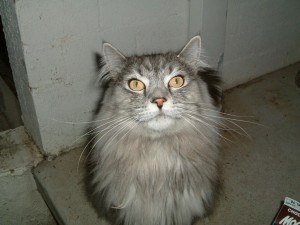 At first Gus’s carer thought he had hair balls. So did the friends she asked. He gagged and convulsed and brought up froth. She gave him some laxative paste.
At first Gus’s carer thought he had hair balls. So did the friends she asked. He gagged and convulsed and brought up froth. She gave him some laxative paste.
Everything in the litter tray seemed normal and for a while Gus seemed OK.
When she rushed off to work he was curled up on the lounge in the sun room as usual.
But the gagging started up again, especially at night. She noticed that he wasn’t eating all his dinner and sometimes he stopped in the middle of the gagging and breathed heavily.
One night he crept on to the end of the bed and wheezed and gasped for breath until she was sure he was choking to death.
Next morning she rushed him into us. We X-rayed his chest and found a very hazy lung and signs of chronic bronchitis.
We took samples from Gus’s lungs and found he had pneumonia. Gus had developed an airway and lung infection on top of the chronic bronchitis.
Cats get asthma and bronchitis, just like humans do. For some it is worse when there are lots of pollens blowing about, for others being cooped up inside with the stagnant air and dust mites in winter set the wheezing and coughing off.
His carer remembered that he had always had a bit of a wheeze, especially in spring and early summer. She hadn’t thought much of it.
It is very easy to confuse coughing with vomiting or regurgitation. Usually food or bile will come up at some stage with vomiting. Vomiting cats often lose their appetite or have diarrhoea as well. Coughing cats don’t go off their food unless they develop an infection as well.
Some asthmatic cats have life threatening breathing difficulties if they are not treated adequately. If you notice your cat coughing, gagging, breathing with difficulty, especially with the mouth open and the neck extended, contact your vet.
Check out Fritz the Brave for reliable information and support if your cat has asthma or bronchitis in cats.
Gus is back to his irascible self after a long course of antibiotics. He’s getting used to a puffer and spacer, and quite likes all the attention we give him.
Switching to a kidney diet
Why should I feed my cat with kidney disease special food?
What is so special about kidney diets?
When should I start feeding my cat a special kidney diet?
We recommend starting a special kidney diet when your cat is in stage 2 kidney (also known as renal) disease. This means that the blood creatinine levels are over 140 and/or the urine concentrating ability, the urine specific gravity (USG) is less than 1.036.
Cats in stage 2 kidney disease usually still have good appetites and are more likely to accept a new food.
How do I convince my cat to eat the new food?
Snotty-nosed and snuffly cats are difficult to live with. Their owners put up with sneezes and snot all over the house, as well as snuffles and grumbles all day and half the night.
The causes of sinusitis and rhinosinusitis are also difficult for vets to diagnose accurately and even more difficult to treat effectively.
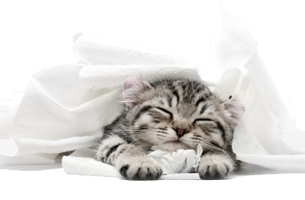 Inflammation and infection spread rapidly from cats’ throats to adjacent structures, such as the middle ear, frontal sinuses, nose and tympanic bullae. These cavities are difficult to reach with medical or surgical treatments.
Inflammation and infection spread rapidly from cats’ throats to adjacent structures, such as the middle ear, frontal sinuses, nose and tympanic bullae. These cavities are difficult to reach with medical or surgical treatments.
Feline mucus is also thicker than human mucus and medication has a hard time penetrating the mucus to get to the offending microbes.
Feline Herpesvirus is the most common initiating cause of chronic rhinitis and rhinosinusitis. It causes chronic airway inflammation and swelling, destroys the normal lining of the nasal cavity and upsets the normal mucus layers. The nasal cavity cannot remove foreign particles or the abnormal mucus and the sinuses become blocked. Bacteria leap in and set up infections making the situation even worse.
Drugs to reduce the mucus and the swelling in the sinuses help a bit. We treat the bacterial infection with antibiotics but are still left with Herpesvirus and all the damage it does. Herpesvirus sinusitis soon flares up into full blown bacterial sinusitis again. Some cats respond well to antiviral drugs but others keep getting intermittent sinusitis.
Nastier causes of similar signs are Cryptococcosis, a fungal disease, and cancer, commonly lymphoma, adenocarcinoma and squamous cell carcinoma. These are difficult to distinguish on X-ray but CT or MRI are very helpful, if they are available. A biopsy clears up any doubts. A blood test is available for Cryptococcosis.
Bad teeth and infected tooth roots sometimes make cats snuffly. A dental inspection and X-ray under general anaesthetic allow targeted and successful treatment.
Occasionally a cat breathes in a grass seed or other foreign body. Usually nasal discharge is from one side only and there is some bleeding.
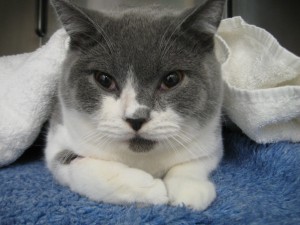 Don’t be tempted to medicate your off-colour cat with paracetamol this holiday season. Paracetamol at any dose is deadly to cats.
Don’t be tempted to medicate your off-colour cat with paracetamol this holiday season. Paracetamol at any dose is deadly to cats.
Soon after ingesting it cats’ red blood cells lose the ability to carry oxygen. The cats’ gums turn brown, they drool and they become weak and wobbly.
If they survive the first 12-24 hours the liver starts to close down, too. They go off their food, their face, lips and paws swell, their gums and eyes go yellow and their belly swells.
Most cats who ingest paracetamol die unless treated within the first couple of hours.
Aspirin is equally dangerous but more subtle in its effects. Aspirin damages cats’ kidneys and irritates their stomachs.
Very few pain medications are safe for cats. Only give medications prescribed by your vet for your particular puss.
 Cats and dogs who live with smokers have a higher risk of developing cancer.
Cats and dogs who live with smokers have a higher risk of developing cancer.
The risk of lymphoma, the most common cancer in cats, is tripled in cats from smoking households. Squamous cell carcinomas of the mouth are also more prevalent in cats exposed to tobacco smoke.
Dogs living in a household with a smoker are more likely to have a chronic cough to match their owner’s. Most sobering of all, they have a higher risk of developing nasal and lung cancer.
Scientists from all over the world have detected nicotine metabolites in the family pets of smokers. The more smokers and smoking in the household, the higher the levels of nicotine metabolites found.
Carbon material, a byproduct of smoking, has also been found in these pets’ lungs.
As if we needed more reasons to give up smoking!
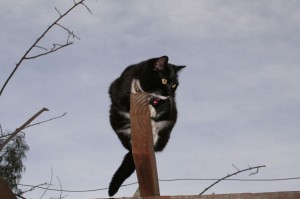
What do kidneys do?
The kidneys remove waste products from the blood stream, regulate fluid and electrolyte balance, maintain the acid-base balance of the body and remove toxins and drugs. They also help maintain blood pressure and stimulate blood cell production.
What happens when my cat’s kidneys fail?
Signs of kidney failure don’t appear until at least 70% of kidney function is lost. Chronic kidney failure is known as renal failure.
Kidney damage accumulates for years before we see any signs. Even then the early signs of kidney failure – increased thirst and urine production – are not easily recognised in our feline friends.
You may notice an increasingly wet litter tray if your cat is only indoors. However if you have other cats you may not pick up increased urine production in a single cat.
Cats often drink from multiple water sources making it difficult to recognise increased consumption.
Other signs of kidney failure such as weight loss and poor coat quality are often put down to normal ageing.
Often the first thing we see is a cat off her food, vomiting, depressed and dehydrated. The kidneys are already badly affected by this stage.
How do we diagnose kidney failure?
We diagnose and stage kidney failure with blood tests for the two waste products, urea and creatinine and a urine analysis to measure the kidneys ability to concentrate urine. We also check the urine for protein loss or a urinary tract infection.
Tests for other substances like potassium, phosphorus and calcium as well as blood cell counts help us decide on the best course of treatment.
Could it have been diagnosed earlier?
Because signs of kidney failure and rises in blood urea and creatinine are not evident until significant loss of kidney function has occurred early diagnosis is difficult. However, we strongly recommend at least annual blood and urine tests, as well as regular body weight checks. If urine concentrating ability is deteriorating or the creatinine is trending up we are able to slow down the progression of the disease with a special kidney protective diet. Any weight loss in a cat should be fully investigated.
What treatments are available?
After initial hospitalisation to treat dehydration and electrolyte disturbances, most cats are managed with a diet change and one or two other medications.
FRESH WATER MUST BE AVAILABLE AT ALL TIMES
How long can I expect my cat to live?
Unfortunately aged kidneys do not recover. However, we can slow the progress of the disease and improve your cat’s well being with treatment and regular checkups. We check phosphorous and potassium levels to see if your cat requires supplements and check for urinary tract infections at least every 3 months. This should give your cat a good stretch of high quality, active life.
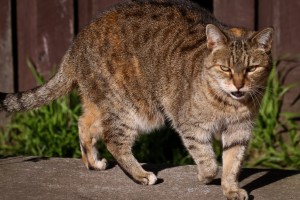 Cats typically have a hate-hate relationship with any strange cat in their presence, yard, or environment. When new cats meet, they fluff up, spit, hiss – more like scream! – and the fur soon goes flying. While the brawl may only last a few seconds, that’s enough time for a few diseases to jump bodies.
Cats typically have a hate-hate relationship with any strange cat in their presence, yard, or environment. When new cats meet, they fluff up, spit, hiss – more like scream! – and the fur soon goes flying. While the brawl may only last a few seconds, that’s enough time for a few diseases to jump bodies.
Feline leukemia (FeLV), feline immunodeficiency virus or cat AIDS (FIV), infectious peritonitis (FIP), or nasty bacterial infections are transmitted from cat to cat in saliva.
Outside cats, particularly unneutered males, love to fight. Most times they will end up with a nasty abscess.
What exactly is an abscess? It’s basically a pocket of pus under the skin. It makes a cat very ill because of the bacteria and toxins it releases into the bloodstream. He is feverish, goes off his food, hides and sleeps a lot.
Treatment for abscesses involves a general anaesthesia, clipping and cleaning the skin, lancing the abscess and flushing all the pus out, placing a drain to allow any new pus to empty, antibiotics and pain relief. Some cats are so sick they need hospitalisation and intravenous fluids for a night or two.
How do we avoid all this??
Desex your cat if he is still entire. Keep him indoors, particularly in the evenings and at night when the brawling usually happens.
Keep other cats off your property. A dog on patrol will soon despatch an intruder. Otherwise keep an eye out for a few evenings and frighten strays off with a loud noise.
Catch the infection as soon as possible. If your cat has been in a fight bring him immediately for an antibiotic shot to discourage the abscess from forming.
Vaccinate your cat against FIV, Feline AIDS. There are three shots in the initial course. A booster at the annual checkup and vaccine review prevents the virus gaining a toe hold.
 Jonah reports that snakes are out and about again. He found one on Saturday night. His carers thought he wasn’t himself on Sunday but when they came home on Monday and found him not able to stand they were sure he wasn’t well. His breathing was a bit laboured and his eyes were huge.
Jonah reports that snakes are out and about again. He found one on Saturday night. His carers thought he wasn’t himself on Sunday but when they came home on Monday and found him not able to stand they were sure he wasn’t well. His breathing was a bit laboured and his eyes were huge.
When we saw him he complained of his plight in a rather plaintive voice. His legs were very weak and he could hardly hold his head up.
This “floppy doll” weakness in a young cat at this time of year rang alarm bells for us.
Adventurous cats and snakes rousing from their winter snooze on a hot weekend are a recipe for disaster! Snakes are especially full of venom at the beginning of the season.
Jonah had some brown snake antivenom and has been on a drip to keep him hydrated. Cats paralysed by snake venom soon become dehydrated because they cannot eat or drink. Jonah has responded well and hopes to go home today!